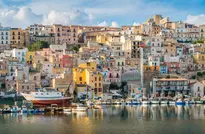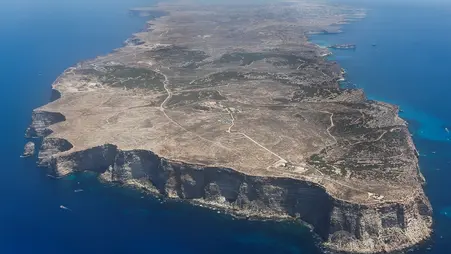
Agrigento, una delle città più emblematiche della Sicilia, è un luogo dove storia, cultura e bellezze naturali si intrecciano in un affresco straordinario. La città è celebre in tutto il mondo per la Valle dei Templi, uno dei siti archeologici più importanti dell’antichità, che ospita resti magnifici di templi dorici, tra cui il Tempio di Concordia, perfettamente conservato. Passeggiare tra queste rovine antiche, con il loro fascino senza tempo e il panorama mozzafiato sulla valle e sul mare, è un’esperienza che fa rivivere l’antica grandezza della città di Akragas, una delle più importanti colonie greche. Il centro storico di Agrigento, con le sue viuzze strette e i palazzi nobiliari, è un affascinante labirinto che conserva l’autenticità siciliana. La Cattedrale di San Gerlando e la Scala dei Turchi, una spettacolare formazione rocciosa bianca che si affaccia sul mare, sono altre meraviglie che arricchiscono la città e i suoi dintorni. Agrigento è anche famosa per il suo Teatro Comunale e per i musei che raccontano la sua storia millenaria, come il Museo Archeologico Regionale, che ospita una collezione di reperti che spaziano dall’epoca greca a quella romana. La gastronomia di Agrigento è un’altra attrazione, con piatti tipici che riflettono la tradizione siciliana. Dalla pasta alla Norma ai dolci come la cassata e i cannoli, ogni pietanza è una celebrazione dei sapori autentici della terra. La città è anche famosa per i suoi vini pregiati, prodotti nelle campagne circostanti, e per i suoi oliveti e agrumeti. Agrigento è una città che racconta storie antiche e che, grazie alla sua bellezza naturale, al suo patrimonio storico e culturale e alla calda ospitalità dei suoi abitanti, riesce a incantare chiunque la visiti. Un luogo dove il passato vive nel presente, e dove ogni angolo, ogni monumento, ogni paesaggio trasmette una sensazione unica di meraviglia e di connessione con la storia e la natura della Sicilia.
Posti da vedere

Lampedusa
Lampedusa, la più grande delle Isole Pelagie, è un angolo di paradiso che si trova nel cuore del Mediterraneo, a metà strada tra la Sicilia e il continente africano. La sua bellezza selvaggia e incontaminata è un vero e proprio rifugio per chi cerca un contatto profondo con la natura e la tranquillità. Le acque cristalline che bagnano le sue coste, le spiagge di sabbia finissima come quella dei Conigli, una delle più belle al mondo, e le scogliere a picco sul mare creano paesaggi spettacolari che incantano ogni visitatore. Lampedusa è famosa anche per la sua fauna, in particolare per la presenza della tartaruga caretta caretta, che nidifica sulle sue spiagge, rendendo l'isola una meta privilegiata per gli amanti della natura e della biodiversità. Il mare che circonda l'isola è ideale per chi ama le immersioni, con fondali ricchi di vita marina e grotte sottomarine da esplorare. Il centro abitato di Lampedusa è un piccolo borgo che conserva l'autenticità siciliana, con le sue case bianche, le piazze tranquille e il porto che accoglie i pescherecci locali. La vita sull'isola è semplice e rilassata, e la gastronomia è fortemente influenzata dal mare: pesce fresco, aragoste, coniglio all'isola e piatti a base di prodotti locali sono il cuore della cucina lampedusana. Lampedusa è una meta ideale per chi cerca un angolo di Sicilia più lontano dal turismo di massa, dove il mare, la natura e la tradizione creano un’atmosfera unica. Un'isola che, con la sua bellezza naturale e la sua tranquillità, rappresenta un vero rifugio dal mondo frenetico, dove ogni angolo offre uno spettacolo mozzafiato e ogni giorno è una nuova scoperta di pace e serenità.

Piazza Armerina
Piazza Armerina, situata nell'entroterra siciliano, è una cittadina che affascina per la sua storia, la sua architettura e la sua atmosfera tranquilla. Immersa nel cuore della provincia di Enna, ma storicamente legata ad Agrigento, Piazza Armerina è famosa in tutto il mondo per la Villa Romana del Casale, uno dei siti archeologici più straordinari d’Italia. Questo complesso residenziale romano, patrimonio dell'umanità UNESCO, è celebre per i suoi mosaici finemente conservati, che raccontano storie mitologiche e quotidiane con un dettaglio straordinario. La villa, circondata da una campagna rigogliosa, è un capolavoro dell’arte e dell’ingegneria romana e una delle attrazioni principali della Sicilia. Il centro storico di Piazza Armerina, con le sue vie strette e tortuose, è un viaggio nel passato, tra palazzi nobiliari, chiese e monumenti che conservano l'impronta di diverse epoche storiche, dal Medioevo al Barocco. La Cattedrale di Piazza Armerina, con la sua facciata imponente, e il Castello Aragonese, che domina il panorama, sono due delle principali testimonianze del passato della città. Le piazze, animate dalla vita quotidiana, offrono un’atmosfera accogliente e tipicamente siciliana, dove è possibile assaporare il vero spirito dell’isola. La gastronomia di Piazza Armerina è un’altra delle sue attrazioni, con piatti tipici che riflettono la ricca tradizione agricola e culinaria della Sicilia interna. I formaggi locali, i salumi, le paste fresche e i dolci tradizionali come i cannoli e le cassate sono solo alcune delle prelibatezze che si possono gustare. La città è anche un punto di partenza ideale per esplorare i paesaggi rurali circostanti, ricchi di oliveti e vigneti, che contribuiscono alla fama dei prodotti tipici della zona.

Licata
Licata, situata sulla costa meridionale della Sicilia, è una cittadina affacciata sul mare che incanta per la sua bellezza semplice e autentica. Il suo porto, uno dei più importanti della regione, è da sempre cuore pulsante dell’economia locale, un luogo di scambio commerciale e di tradizione marinara. Licata conserva una parte del suo fascino antico, con il centro storico che si snoda tra viuzze strette, piazze vivaci e chiese, tra cui la Chiesa Madre, che testimoniano la storia e la cultura della città. Le spiagge di Licata sono un altro dei suoi tesori, con lunghe distese di sabbia dorata e acque cristalline, che attirano i visitatori in cerca di relax e tranquillità. Le spiagge di Marianello e Gela sono perfette per chi ama il mare calmo e il sole siciliano, mentre i dintorni offrono una natura incontaminata, ideale per passeggiate e per chi vuole esplorare le bellezze paesaggistiche dell’isola. Licata è anche una città di tradizioni gastronomiche, dove il pesce fresco, le specialità a base di tonno e il buon olio d’oliva sono i protagonisti della cucina locale. I piatti tipici, spesso preparati con ingredienti genuini e locali, rappresentano un’autentica esperienza sensoriale per chi desidera assaporare il vero gusto della Sicilia. Con il suo fascino discreto, Licata è una destinazione perfetta per chi cerca una Sicilia autentica, lontana dai circuiti turistici più affollati. Un luogo dove la storia, la cultura, il mare e la tradizione gastronomica si intrecciano, creando un’atmosfera calda e accogliente che rimane nel cuore di chi la visita.

Sciaccia
Sciacca, affacciata sul Mar Mediterraneo, è una pittoresca cittadina della costa sud-occidentale della Sicilia che incanta per la sua bellezza naturale e il suo fascino storico. Con le sue case bianche, i vicoli stretti e le piazze vivaci, Sciacca conserva l’autenticità di un borgo marinaro che ha saputo adattarsi alle esigenze moderne senza perdere la sua essenza. Il centro storico è un labirinto di stradine dove si possono scoprire chiese, palazzi nobiliari e antichi quartieri che raccontano la lunga storia della città, che risale all’antichità greca e romana. Sciacca è famosa per le sue terme, che sfruttano le acque sulfuree naturali per offrire trattamenti benefici da secoli. Il complesso termale, immerso nel verde, è un’oasi di benessere che attira visitatori in cerca di relax e rigenerazione. Oltre alle terme, la città è nota per il suo porto, che è ancora oggi un punto centrale dell’economia locale, legato principalmente alla pesca e alla lavorazione del pesce. Le spiagge di Sciacca, con le loro acque limpide e la sabbia dorata, sono una delle principali attrazioni della zona. Tra le più note ci sono quelle di San Marco e della località di Capo San Marco, che offrono spazi tranquilli dove godersi il mare in totale relax. La costa, rocciosa e frastagliata in alcuni punti, regala anche scenari mozzafiato, ideali per chi ama passeggiare e scoprire angoli nascosti. La gastronomia di Sciacca è fortemente influenzata dal mare, con piatti tipici a base di pesce fresco, crostacei e tonno, ma anche dalla tradizione agricola siciliana, con piatti a base di verdure, legumi e olio d’oliva. I dolci tipici, come le “cassatelle” e i “cubbaiti”, sono una delizia per i palati più golosi.

Porto Empedocle
Porto Empedocle, affacciata sulla costa sud della Sicilia, è una cittadina che incarna la tradizione marinara e il fascino rustico di un borgo siciliano. Con il suo porto, uno dei più significativi della regione, Porto Empedocle è da sempre punto di riferimento per il commercio e la pesca, e il suo litorale, che si estende tra scogli e sabbia, offre un paesaggio suggestivo e sereno. La città prende il nome dal filosofo Empedocle, che nacque qui, e conserva una forte identità legata alla sua storia, alla cultura e alla vita di mare. Il centro di Porto Empedocle, con le sue stradine vivaci, le piazze e i palazzi tipici, offre scorci caratteristici che raccontano una Sicilia genuina e un po' più lontana dalle rotte turistiche più frequentate. La Chiesa Madre e il vecchio faro, che ancora oggi guida le navi, sono luoghi simbolici di una città che ha sempre avuto un legame profondo con il mare. Le spiagge di Porto Empedocle, come quelle di Punta Piccola e Marinella, sono perfette per chi cerca una sosta al mare in un ambiente tranquillo, lontano dalla folla. Il mare è cristallino, ideale per nuotare, fare snorkeling o semplicemente godersi il sole siciliano. La vicinanza alla Valle dei Templi di Agrigento, uno dei siti archeologici più importanti d'Italia, aggiunge un elemento di grande valore storico e culturale a questa località. La cucina di Porto Empedocle è fortemente influenzata dalla tradizione marinara, con piatti a base di pesce fresco, tonno e piatti tipici siciliani che raccontano l’autenticità della terra e del mare. Con i suoi piatti semplici e genuini, la gastronomia locale è un'esperienza che affascina e soddisfa i sensi. Porto Empedocle è un angolo di Sicilia dove la bellezza del mare e la tranquillità del paesaggio si mescolano con la storia e la cultura della sua gente, creando un’atmosfera calda e accogliente. Un luogo che offre il meglio della Sicilia più autentica, con la sua vivacità marittima, i panorami mozzafiato e una storia millenaria che la rende unica e affascinante.

Realmonte
Realmonte, un incantevole borgo situato sulla costa sud della Sicilia, è una piccola gemma che affascina per la sua bellezza naturale e la tranquillità che offre. La sua posizione privilegiata, affacciata sul Mar Mediterraneo, regala panorami mozzafiato, con acque cristalline e spiagge dorate che attirano visitatori in cerca di relax e serenità. Ma Realmonte è anche famosa per la sua vicinanza alla straordinaria Scala dei Turchi, una delle formazioni rocciose più suggestive d’Italia, con pareti bianche che si ergono a picco sul mare, creando un contrasto spettacolare con il blu intenso dell’acqua. Il centro storico di Realmonte è caratterizzato da stradine tranquille e case tipiche che mantengono il fascino di un paese siciliano autentico, dove la vita scorre a un ritmo più lento rispetto alle mete turistiche più affollate. Il borgo offre scorci pittoreschi, chiese e piazze dove si respira un’atmosfera di semplicità e accoglienza. La gastronomia di Realmonte è strettamente legata alla tradizione siciliana, con piatti a base di pesce fresco, come il tonno e la spigola, ma anche con prodotti tipici dell’entroterra, come gli agrumi e l’olio d’oliva, che arricchiscono la cucina locale. La ricchezza dei sapori e la genuinità degli ingredienti rendono ogni pasto un’esperienza autentica. Realmonte è un angolo di Sicilia che incanta per la sua bellezza naturale, la sua tranquillità e l’autenticità del suo territorio. Con la Scala dei Turchi a fare da sfondo, il mare cristallino e le tradizioni gastronomiche, rappresenta una destinazione ideale per chi cerca una Sicilia più nascosta, lontano dalle folle, ma ricca di storia, cultura e paesaggi indimenticabili.
Le più belle spiagge

Palma di Montechiaro

Licata

San Marco

Licata

Montallegro

Licata

Realmonte

Lampedusa

Lampedusa




















